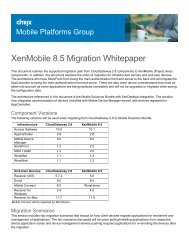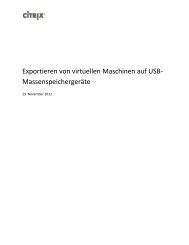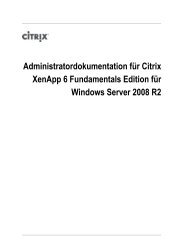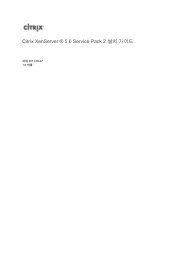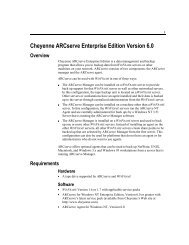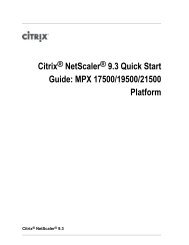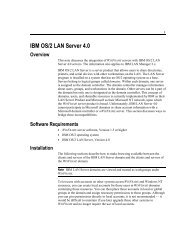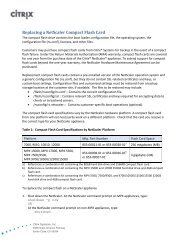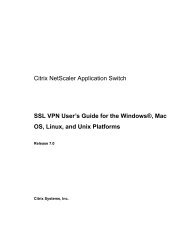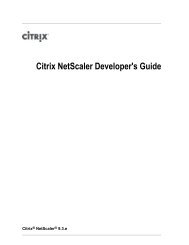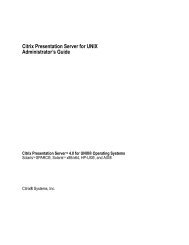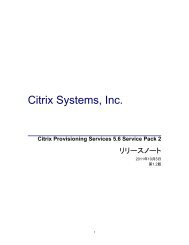NetScaler Application Firewall and the OWASP Top Ten – 2013
NetScaler Application Firewall and the OWASP Top Ten – 2013
NetScaler Application Firewall and the OWASP Top Ten – 2013
Create successful ePaper yourself
Turn your PDF publications into a flip-book with our unique Google optimized e-Paper software.
<strong>NetScaler</strong> <strong>Application</strong> <strong>Firewall</strong> <strong>and</strong> <strong>the</strong><strong>OWASP</strong> <strong>Top</strong> <strong>Ten</strong> <strong>–</strong> <strong>2013</strong>IntroductionThe Open Web <strong>Application</strong> Security Project (<strong>OWASP</strong>; http://www.owasp.org) released <strong>the</strong> <strong>OWASP</strong> <strong>Top</strong> 10 for<strong>2013</strong> for web application security. This list documents <strong>the</strong> most common web application vulnerabilities <strong>and</strong> isa great starting point to evaluate web security. Here we detail how to configure <strong>the</strong> <strong>NetScaler</strong> <strong>Application</strong><strong>Firewall</strong> to mitigate <strong>the</strong>se flaws. <strong>Application</strong> <strong>Firewall</strong> is available as an integrated module in <strong>the</strong> <strong>NetScaler</strong><strong>Application</strong> Delivery Controller (Platinum Edition) as well as a complete range of appliances.The full <strong>OWASP</strong> <strong>Top</strong> 10 document is available at http://www.owasp.org/index.php/<strong>OWASP</strong>_<strong>Top</strong>_<strong>Ten</strong>_Project.<strong>OWASP</strong> <strong>Top</strong>-10 <strong>2013</strong><strong>NetScaler</strong> FeaturesA1- Injection Injection attack prevention (SQL or any o<strong>the</strong>rcustom injections such as OS Comm<strong>and</strong>injection, XPath injection, <strong>and</strong> LDAPInjection), auto update signature featureA2 - Broken Au<strong>the</strong>ntication <strong>and</strong> SessionManagementA3 - Cross Site Scripting (XSS)AAA, Cookie Tampering protection, CookieProxying, Cookie Encryption, CSRF tagging,Use SSLXSS Attack Prevention, Blocks all <strong>OWASP</strong> XSScheat sheet attacksPage 1
A4 - Insecure Direct Object ReferencesA5 - Security MisconfigurationA6 - Sensitive Data ExposureA7 - Missing Function Level Access ControlA8 - Cross Site Request ForgeryA9 - Using Components with knownVulnerabilitiesA10 - Unvalidated Redirects <strong>and</strong> ForwardsStartURL checks, AAA, Form protections, <strong>and</strong>Cookie tampering protectionsPCI reports, SSL features, Signaturegeneration from vulnerability scan reportssuch as Ceznic, Qualys , <strong>and</strong> Whitehat.Additionally, very specific protections such asCookie encryption, proxying, <strong>and</strong> tampering.Credit Card protection, Safe Commerce,Cookie proxying, <strong>and</strong> Cookie EncryptionAuthorization security feature within AAAmodule of <strong>NetScaler</strong>, StartURL, <strong>and</strong>ClosureURLCSRF form tagging, Referer header validationVulnerability scan reports, <strong>Application</strong><strong>Firewall</strong> Templates, <strong>and</strong> Custom SignaturesProtections by policy control, field formatprotection configurationA1 - InjectionInjection flaws such as SQL, OS, <strong>and</strong> LDAP injection occur when untrusted data is sent to an interpreter as partof a comm<strong>and</strong> or query. The attacker’s hostile data can trick <strong>the</strong> interpreter into executing unintendedcomm<strong>and</strong>s or accessing data without proper authorization.<strong>NetScaler</strong> Protection●●●●●SQL Injection prevention feature protects against common injection attacks. Custom injection patternscan be uploaded to protect against any type of injection attack including XPath <strong>and</strong> LDAP. This isapplicable for both HTML <strong>and</strong> XML payloads.The auto update signature feature keeps <strong>the</strong> injection signatures up to date.Field format protection feature allows <strong>the</strong> administrator to restrict any user parameter to a regularexpression. For instance, you can enforce that a zip-code field contains integers only or even 5-digitintegers.Form field consistency: Validate each submitted user form against <strong>the</strong> user session form signature toensure validity of all form elements.Buffer overflow checks ensure that <strong>the</strong> URL, headers, <strong>and</strong> cookies are in <strong>the</strong> right limits blocking anyattempts to inject large scripts or code.Page 2
A2 - Broken Au<strong>the</strong>ntication <strong>and</strong> Session Management<strong>Application</strong> functions related to au<strong>the</strong>ntication <strong>and</strong> session management are often not implemented correctly,allowing attackers to compromise passwords, keys, or session tokens, or to exploit o<strong>the</strong>r implementationflaws to assume o<strong>the</strong>r users’ identities.<strong>NetScaler</strong> Protections●●●<strong>NetScaler</strong> AAA module performs user au<strong>the</strong>ntication <strong>and</strong> provides Single Sign-On functionality tobackend applications. This is integrated into <strong>NetScaler</strong> AppExpert policy engine to allow custompolicies based on user <strong>and</strong> group information.Additionally, using <strong>the</strong> Cookie tampering protection feature, session ID commonly stored in cookiescan be protected. Using SSL offloading <strong>and</strong> URL transformation capabilities, <strong>the</strong> firewall can also helpsites to use secure transport layer protocols to prevent stealing of session tokens by network sniffing.Cookie Proxying <strong>and</strong> Cookie Encryption can be employed to completely mitigate cookie stealing <strong>and</strong>hence securing <strong>the</strong> session.A3 - Cross Site Scripting ( XSS )XSS flaws occur whenever an application takes untrusted data <strong>and</strong> sends it to a web browser without propervalidation or escaping. XSS allows attackers to execute scripts in <strong>the</strong> victim’s browser which can hijack usersessions, deface web sites, or redirect <strong>the</strong> user to malicious sites.<strong>NetScaler</strong> Protections●●●●XSS protection protects against common XSS attacks. Custom XSS patterns can be uploaded to modify<strong>the</strong> default list of allowed tags <strong>and</strong> attributes. The <strong>NetScaler</strong> <strong>Application</strong> <strong>Firewall</strong> uses a white list ofallowed HTML attributes <strong>and</strong> tags to detect XSS attacks. This is applicable for both HTML <strong>and</strong> XMLpayloads.<strong>NetScaler</strong> <strong>Application</strong> <strong>Firewall</strong> blocks all <strong>the</strong> attacks listed in <strong>OWASP</strong> XSS Filter Evaluation Cheat Sheet.Field format check prevents an attacker from sending inappropriate web form data which can be apotential XSS attack.Form field consistency.A4 - Insecure Direct Object ReferencesA direct object reference occurs when a developer exposes a reference to an internal implementation objectsuch as a file, directory, or database key. Without an access control check or o<strong>the</strong>r protection, attackers canmanipulate <strong>the</strong>se references to access unauthorized data.Page 3
<strong>NetScaler</strong> Protections●●●●Start URL check with URL closure: Allows user access to a predefined white list of URLs. URL closurebuilds a list of all URLs seen in valid responses during <strong>the</strong> user session <strong>and</strong> automatically allows accessto <strong>the</strong>m during that session.AAA feature that supports au<strong>the</strong>ntication, authorization, <strong>and</strong> auditing for all application traffic allows asite administrator to manage access controls with <strong>the</strong> <strong>NetScaler</strong> appliance.Form field consistency: If object references are stored as hidden fields in forms, <strong>the</strong>n using form fieldconsistency you can validate that <strong>the</strong>se fields are not tampered on subsequent requests.Cookie Proxying <strong>and</strong> Cookie consistency: Object references that are stored in cookie values can bevalidated with <strong>the</strong>se protections.A5 - Security MisconfigurationGood security requires having a secure configuration defined <strong>and</strong> deployed for <strong>the</strong> application, frameworks,application server, web server, database server, <strong>and</strong> platform. Secure settings should be defined,implemented, <strong>and</strong> maintained as defaults are often insecure. Additionally, software should be kept up to date.<strong>NetScaler</strong> Protections●●●The PCI-DSS report generated by <strong>the</strong> <strong>Application</strong> <strong>Firewall</strong>, documents <strong>the</strong> security settings on <strong>the</strong><strong>Firewall</strong> device.Reports from <strong>the</strong> scanning tools are converted to <strong>NetScaler</strong> Signatures to h<strong>and</strong>le securitymisconfigurations.<strong>NetScaler</strong> <strong>Application</strong> <strong>Firewall</strong> supports Cenzic, IBM AppScan (Enterprise <strong>and</strong> St<strong>and</strong>ard), Qualys,TrendMicro, WhiteHat, <strong>and</strong> custom vulnerability scan reports.A6 - Sensitive Data ExposureMany web applications do not properly protect sensitive data such as credit cards, tax IDs, <strong>and</strong> au<strong>the</strong>nticationcredentials. Attackers might steal or modify such weakly protected data to conduct credit card fraud, identity<strong>the</strong>ft, or o<strong>the</strong>r crimes. Sensitive data deserves extra protection such as encryption at rest or in transit, as wellas special precautions when exchanged with <strong>the</strong> browser.<strong>NetScaler</strong> Protection●●●<strong>Application</strong> <strong>Firewall</strong> protects applications from leaking sensitive data like credit card details.Sensitive data can be configured as Safe objects in Safe Commerce protection to avoid exposure.Any sensitive data in cookies can be protected by Cookie Proxying <strong>and</strong> Cookie Encryption.Page 4
A7 - Missing Function Level Access ControlMost web applications verify function level access rights before making that functionality visible in <strong>the</strong> UserInterface (UI). However, applications need to perform <strong>the</strong> same access control checks on <strong>the</strong> server when eachfunction is accessed. If requests are not verified, <strong>the</strong>n attackers will be able to forge requests to accessfunctionality without proper authorization.<strong>NetScaler</strong> Protections●●The Authorization security feature within AAA module of <strong>NetScaler</strong> appliance enables <strong>the</strong> appliance toverify, which content on a protected server it should allow each user to access.Additionally, StartURL <strong>and</strong> ClosureURL features can be used to provide restricted access to server.A8 - Cross Site Request ForgeryA CSRF attack forces a logged-on victim’s browser to send a forged HTTP request, including <strong>the</strong> victim’s sessioncookie <strong>and</strong> any o<strong>the</strong>r automatically included au<strong>the</strong>ntication information, to a vulnerable web application. Thisallows <strong>the</strong> attacker to force <strong>the</strong> victim’s browser to generate requests, which <strong>the</strong> vulnerable application thinksare legitimate requests from <strong>the</strong> victim.<strong>NetScaler</strong> Protections●●●CSRF Tagging: This adds a unique token to each form sent to a user <strong>and</strong> validates <strong>the</strong> token onsubsequent submissions.Referrer headers can be validated to ensure that <strong>the</strong> requests were generated from within <strong>the</strong> site.Referrer header check in coordination with URL Closure feature can prevent CSRF.A9 - Using Components with Known VulnerabilitiesComponents such as libraries, frameworks, <strong>and</strong> o<strong>the</strong>r software modules, almost always run with full privileges.If a vulnerable component is exploited, <strong>the</strong>n such an attack can facilitate serious data loss or server takeover.<strong>Application</strong>s using components with known vulnerabilities might undermine application defenses <strong>and</strong> enable arange of possible attacks <strong>and</strong> impacts.<strong>NetScaler</strong> Protections●●●●Citrix recommends to have <strong>the</strong> third party components up to date.Vulnerability scan reports that are converted to <strong>NetScaler</strong> Signatures can be used to virtually patch<strong>the</strong>se components.<strong>Application</strong> <strong>Firewall</strong> templates that are available for <strong>the</strong>se vulnerable components can be used.Custom Signatures can be bound with firewall to protect <strong>the</strong>se components.Page 5
A10 - Unvalidated Redirects <strong>and</strong> ForwardsWeb applications frequently redirect <strong>and</strong> forward users to o<strong>the</strong>r pages <strong>and</strong> web sites, <strong>and</strong> use untrusted datato determine <strong>the</strong> destination pages. Without proper validation, attackers can redirect victims to phishing ormalware sites, or use forwards to access unauthorized pages.<strong>NetScaler</strong> ProtectionsOn all incoming requests do,●●●Field format protection: Specify that <strong>the</strong> parameter containing <strong>the</strong> URL for redirection or forward isrestricted to valid allowed domains.Referrer header check: To reduce phishing attacks, validate <strong>the</strong> referrer header on incoming requests.Use AAA authorization policies to ensure that access to specific URLs is authorized.On <strong>the</strong> Redirect responses,●●Use Responder policies to ensure that 302 redirects are allowed to valid domains only.Use URL transform or rewrite policies to transform all 302 redirects to specific allowed domains.For More InformationDownload <strong>and</strong> try <strong>the</strong> <strong>Application</strong> <strong>Firewall</strong> in <strong>NetScaler</strong> VPX virtual appliance with a free 90-dayPlatinum Edition evaluation license today at http://www.citrix.com/netscalervpx.<strong>NetScaler</strong> Product documentation can be found at http://support.citrix.com/product/nsad/v10.1.Follow us on twitter at http://twitter.com/netscaler <strong>and</strong> join <strong>the</strong> Citrix community athttp://community.citrix.com.About CitrixCitrix (NASDAQ:CTXS) is <strong>the</strong> cloud company that enables mobile workstyles—empowering people to work <strong>and</strong> collaborate from anywhere, easily<strong>and</strong> securely. With market-leading solutions for mobility, desktop virtualization, cloud networking, cloud platforms, collaboration <strong>and</strong> data sharing,Citrix helps organizations achieve <strong>the</strong> speed <strong>and</strong> agility necessary to succeed in a mobile <strong>and</strong> dynamic world. Citrix products are in use at more than260,000 organizations <strong>and</strong> by over 100 million users globally. Annual revenue in 2012 was $2.59 billion. Learn more at www.citrix.com.Copyright © <strong>2013</strong> Citrix Systems, Inc. All rights reserved. Citrix, <strong>the</strong> Citrix logo, Citrix <strong>NetScaler</strong>, <strong>and</strong> o<strong>the</strong>r Citrix product names aretrademarks of Citrix Systems, Inc. All o<strong>the</strong>r product names, company names, marks, logos, <strong>and</strong> symbols are trademarks of <strong>the</strong>irrespective owners.Page 6



